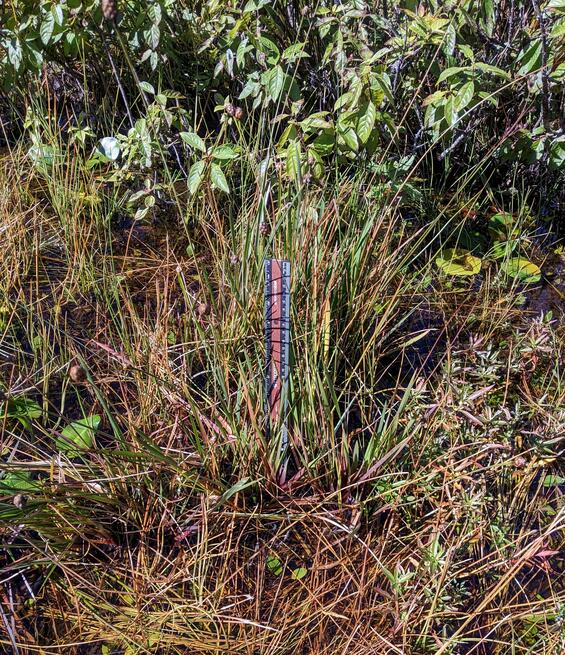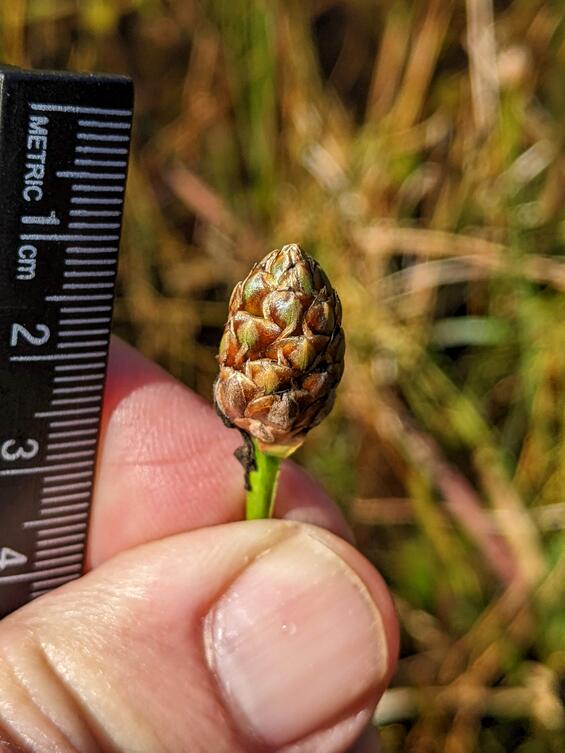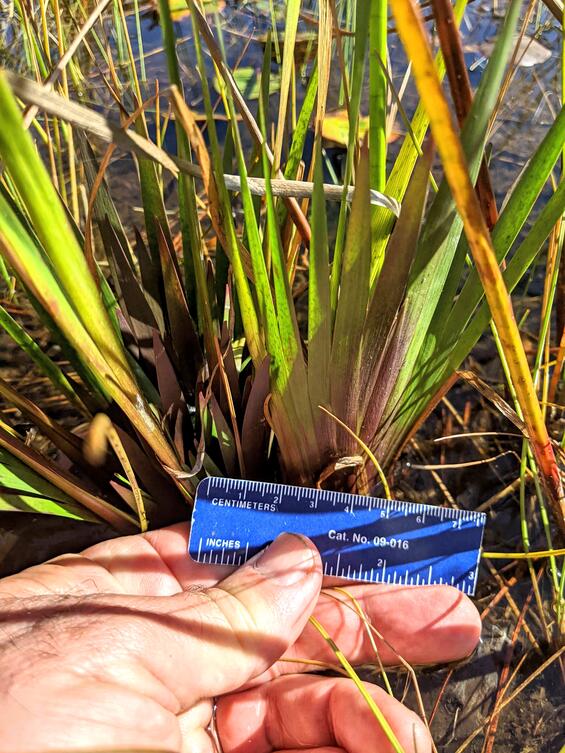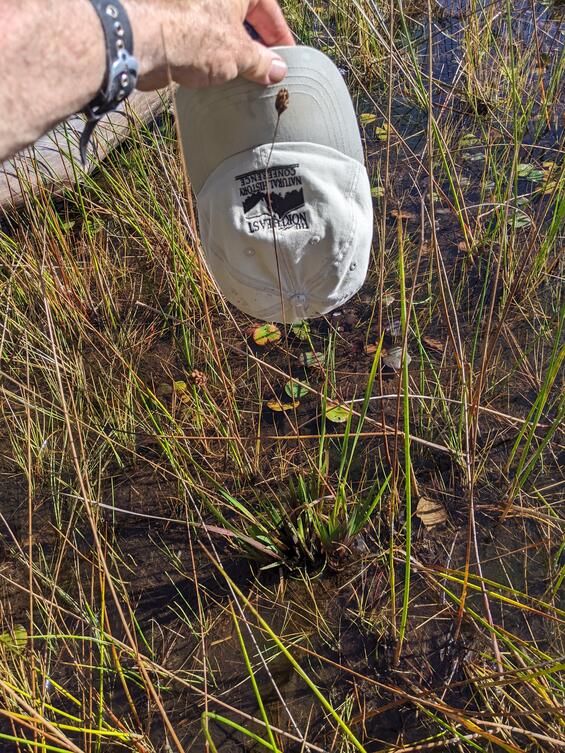- Scientific name: Xyris smalliana Nash
- Species of Greatest Conservation Need (MA State Wildlife Action Plan)
Description

Small’s yellow-eyed grass, (Xyris smalliana), is an herbaceous perennial of the yellow-eyed grass family of monocots known botanically as the Xyridaceae. The plants are cespitose (clump forming) with shallow fibrous roots with stems that can reach up to a meter in height. The leaves are flattened, ascending in narrow fans, similar to a small iris, and are up to a half meter in height (1.6 ft), 5-15 mm (0.2-0.6 in) wide, with smooth even margins. The basal portions forming sheaths that are pinkish or pale red, and smooth. The upper portion of the leaf blade is a deep green. The flowering stems are straight, slightly compressed toward the top, 2 mm (0.08 in) wide, smooth, 2-ribbed. The spikes are ovoid to ellipsoid or cylindric, 10-20 mm (0.4-0.8 in) in height with rounded, fertile bracts 5-8 mm (0.2-0.31 in), their margins entire and with a well-defined central green patch. The flowers have lateral sepals that are slightly to conspicuously exserted beyond the covering bracts, slightly curved, 6-8 mm (0.24-0.31 in) in length. The margins of the lateral sepals are fringed or lacerated toward the tip. The seeds are translucent, narrowly ellipsoid to ovoid, 0.7 mm (0.03 in) long, irregularly ridged and cross-ridged (Fernald 1950, Krall 2020).
There are four species of yellow-eyed grass present in Massachusetts, including Small’s yellow-eyed grass, slender yellow-eyed grass (Xyris torta), northern yellow-eyed grass (Xyris montana), and bog yellow-eyed grass (Xyris difformis).



Life cycle and behavior
Small’s yellow-eyed grass is an herbaceous perennial.
Population status
Small’s yellow-eyed grass is on the Massachusetts state watch list and has been included as a species of greatest conservation need in Massachusetts. There are currently 5 known populations of Small’s yellow-eyed grass in the state: one in Worcester County, three in Plymouth County and one in Barnstable County. None of these populations are large. In addition to the current populations, Small’s yellow-eyed grass is historically known from Middlesex, Essex, and Norfolk counties (Cullina et al. 2011). There are 80 herbarium specimens from Massachusetts, 78 of which have legible dates, and only 15 of those are from the last 80 years, since 1935 (CHN 2025).
Distribution and abundance
iNaturalist shows that Xyris smalliana is relatively rare across the range with only 251 research grade observations (iNaturalist 2025). It is distributed in all 16 US states with a seacoast from Maine to Texas excepting Virginia and New Hampshire and not occurring in any inland state. NatureServe (2025) shows the status to be critically imperiled in Maine, Connecticut, Maryland, and Louisiana, and vulnerable in North Carolina (NatureServe 2025), with the highest density of populations in Florida (iNaturalist 2025).
Habitat
Small’s yellow-eyed grass is an obligate wetland species that grows in shallow coastal plain ponds, a specialized plant community in Massachusetts, as well as peatlands such as acidic fens, bogs, and pond edge mud flats. Sites tend to be free of trees or shrubs. Associated plants in these communities are herbaceous species including yellow spikesedge (Eleocharis flavescens), mud sedge (Carex limosa), mermaid weed (Proserpinaca palustris), water willow (Decodon verticillata), horned bladderwort (Utricularia cornuta), sundew (Drosera intermedia, D. rotundifolia), yellow water lily (Nuphar variegata), narrow-fruited beaksedge (Rhynchospora inundata), blue flag (Iris versicolor), marsh St. John’s wort (Triadenum virginicum, pitcher plant (Sarracenia purpurea)), rose pogonia (Pogonia ophioglossoides), and white beaksedge (Rhynchospora alba).
Healthy habitats are vital for supporting native wildlife and plants. Explore habitats and learn about conservation and restoration in Massachusetts.
Threats
Non-migratory flocks of Canada geese and mute swans have become common to abundant in these shallow ponds, often eating off large areas of emergent vegetation that include the yellow-eyed grass species. These bird populations have hugely increased in the last 40 years in Massachusetts and pose a serious threat to rare plant populations in this type of habitat (Baker et al. 2018, Cyr and Pace 1993, Jobe et al. 2022, Kjeller et al. 2024, Mass Audubon 2025a, Mass Audubon 2025b, Nichols 2014).
Threats also come from shoreline development, lake and pond associations requesting treatment of aquatic “weeds,” invasive species such as purple loosestrife, gray willow and giant reed grass, off-road vehicle use when ponds dry up (which happens in some locations in a prolonged drought), succession with woody species taking over formerly open bog habitat, and changes in hydrology due to development, road construction or beaver activity.
Conservation
Much more survey work is needed to find more populations, especially because this species is small, in difficult areas to survey, and is difficult to identify and to separate from two other similar species. One approach is to review old specimen data for locations and resurvey those sites to see if the plants might still be there. Surveys of known populations are needed to establish numbers and extent of the population, and gather data on associated species, soil pH and potential threats. Once surveyed, a population should be resurveyed every five years to check on its status.
Conservation planning for Xyris smalliana should focus on land protection and the preservation of natural habitat conditions. Management needs could include hazing of geese and swans to move them off the habitat, and removal or treatment of invasive, non-native plant species. Research is needed for yellow-eyed grass species on seed production, seed fertility, seed dispersal and germination.
Acknowledgement
MassWildlife acknowledges the assistance of Matthew Charpentier who initiated the development of this fact sheet.
References
Bakker, E. S., C. G. F. Veen, G. J. N. Ter Heerdt, N. Huig, and J. M. Sarneel. 2018. High Grazing Pressure of Geese Threatens Conservation and Restoration of Reed Belts. Frontiers in Plant Science 9.
Bertin, R. I, Rawinski, T. J. (2012) Vascular Flora of Worcester County, Massachusetts. New England Botanical Club. 291pp.
Consortium of Northeastern Herbaria. 2025. Herbarium records. https://portal.neherbaria.org/portal/collections/list.php. Accessed 8 April 2025
Cullina M, Connolly B, Sorrie B, Somers P (2011) The vascular plants of Massachusetts: a county checklist, 1st revision. Massachusetts Natural Heritage & Endangered Species Massachusetts Division of Fisheries and Wildlife, Westborough, MA
Cyr, H., and M. L. Pace. 1993. Magnitude and patterns of herbivory in aquatic and terrestrial ecosystems. Nature 361: 148–150.
Dodds, Jill S. 2022. Xyris smalliana Rare Plant Profile. New Jersey Department of Environmental Protection, State Parks, Forests & Historic Sites, State Forest Fire Service & Forestry, Office of Natural Lands Management, New Jersey Natural Heritage Program, Trenton, NJ. 15 pp. Accessed 7 April 2025 [https://www.nj.gov/dep/parksandforests/natural/heritage/docs/xyris-smalliana-Small’s-yellow-eyed-grass.pdf ]
Fernald, M. L. 1950. Gray’s Manual of Botany, Eighth (Centennial) Edition—Illustrated. American Book Company, New York.
Gleason, Henry A., and Arthur Cronquist. 1991. Manual of Vascular Plants of Northeastern United States and Adjacent Canada, Second Edition. Bronx, NY: The New York Botanical Garden.
Haines A. 2011. New England Wild Flower Society’s Flora Novae Angliae: a manual for the identification of native and naturalized higher vascular plants of New England. Yale University Press. 1008 pp.
Jobe, J., C. Krafft, M. Milton, and K. Gedan. 2022. Herbivory by Geese Inhibits Tidal Freshwater Wetland Restoration Success. Diversity 14: 278.
Kjeller, E., J. Waldenström, J. Elmberg, and G. Gunnarsson. 2024. Herbivory on aquatic macrophytes by geese and swans—a review of methods, effects, and management. Ornis Svecica 34: 119–137.
Mass Audubon. 2025. Find a Bird: Canada Goose, Branta canadensis. Mass Audubon Breeding Bird Atlas. Website https://www.massaudubon.org/our-work/birds-wildlife/bird-conservation-research/breeding-bird-atlases/find-a-bird?id=76 [accessed 9 April 2025].
Mass Audubon. 2025. Find a Bird: Mute Swan, Cygnus olor. Mass Audubon Breeding Bird Atlas. Website https://www.massaudubon.org/our-work/birds-wildlife/bird-conservation-research/breeding-bird-atlases/find-a-bird?id=100 [accessed 9 April 2025].
Kral, Robert. Page updated November 5, 2020. Xyris smalliana Ries. In: Flora of North America Editorial Committee, eds. 1993+. Flora of North America North of Mexico [Online]. 22+ vols. New York and Oxford. Accessed April 7, 2025 at http://floranorthamerica.org/Xyris_smalliana
NatureServe. 2025. NatureServe Network Biodiversity Location Data accessed through NatureServe Explorer [web application]. NatureServe, Arlington, Virginia. Available https://explorer.natureserve.org/. Accessed: 4/07/2025.
Nichols, T. C. 2014. Ten years of resident Canada goose damage management in a New Jersey tidal freshwater wetland. Wildlife Society Bulletin 38: 221–228.
Staudinger, M.D., A.V. Karmalkar, K. Terwilliger, K. Burgio, A. Lubeck, H. Higgins, T. Rice, T.L. Morelli, A. D'Amato. 2024. A regional synthesis of climate data to inform the 2025 State Wildlife Action Plans in the Northeast U.S. DOI Northeast Climate Adaptation Science Center Cooperator Report. 406 p. https://doi.org/10.21429/t352-9q86
Contact
| Date published: | May 6, 2025 |
|---|